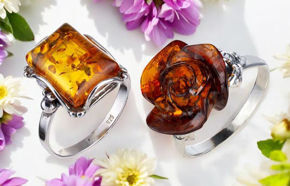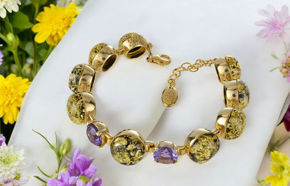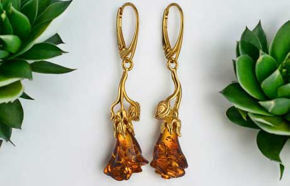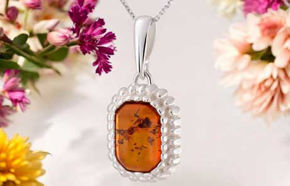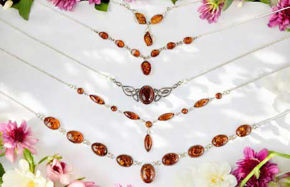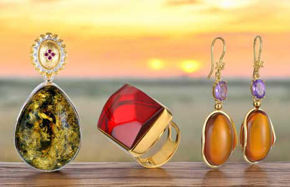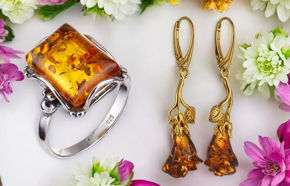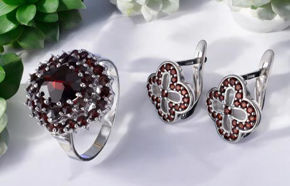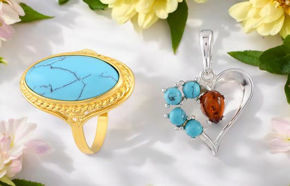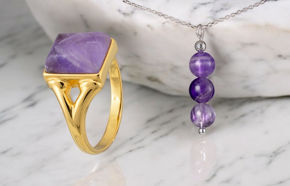Baltic amber earrings are more than just a piece of jewelry; they're a window into ancient history and a testament to nature's artistry. With the rising trend of authenticity in fashion, many are drawn to the unique allure of real amber jewelry. But as demand increases, so does the number of fakes. In this guide, we'll explore how to spot authentic Baltic amber earrings and avoid being deceived by imitations.
The Allure of Baltic Amber Earrings
Baltic amber has been cherished for centuries, not only for its striking beauty but also for its unique origins and properties. Amber jewelry is timeless, blending history with elegance. Its warm, glowing hues can complement any style, making it a favorite among jewelry enthusiasts.
The rising popularity of Baltic amber earrings stems from their distinct charm and the natural beauty they bring to the wearer. These earrings come in a variety of colors, including cognac, lemon, honey, and green, with cognac being a particularly popular choice. However, the market is saturated with synthetic and fake amber, making it crucial for consumers to know how to identify the real deal. In this post, you’ll learn about the origins of Baltic amber, how to spot fakes, where to buy genuine pieces, and how to care for your amber jewelry.
What is Baltic Amber?
Baltic amber is fossilized tree resin that dates back millions of years. It originates from the forests surrounding the Baltic Sea, where ancient trees secreted resin that eventually hardened and turned into amber. This process took place over millennia, creating the stunning amber we admire today.
The significance of Baltic amber in jewelry lies in its unique properties. It often contains inclusions of ancient insects, plants, and other organic materials, making each piece one-of-a-kind. The colors of Baltic amber range from pale yellow to deep brown, with some pieces even displaying green or blue hues.
Amber's lightweight nature and warm feel make it ideal for earrings, necklaces, and bracelets. Its natural beauty and historical significance add to its appeal, making it a cherished material for both casual wear and special occasions.
Identifying Authentic Baltic Amber
Spotting authentic Baltic amber requires a keen eye and some practical knowledge. Here are several ways to determine whether your amber earrings are genuine:
Visual Inspection
Real Baltic amber often contains tiny inclusions or imperfections like bubbles, plant matter, and insects. These inclusions are a hallmark of authenticity, as they are remnants from the amber's formation process millions of years ago. In contrast, fake amber is usually flawless, smooth, and free of inclusions.
Floating Test
One simple test to check the authenticity of amber is the floating test. Real amber is relatively lightweight and will float in saltwater. Mix about 7-8 teaspoons of salt in a cup of water and place the amber in the solution. If it floats, there's a good chance it's genuine. However, be cautious, as some fakes can also float.
UV Light Test
Amber fluoresces under UV light, emitting a blue or green glow. You can use a UV flashlight to test your amber earrings. Hold the light close to the amber and observe the color it emits. Genuine Baltic amber will show a vibrant fluorescence, while synthetic amber might not react or could show a different color.
Hot Needle Test
The hot needle test involves heating a needle and gently poking the amber. Real amber will emit a pine-like smell when poked, while plastic imitations will produce a chemical or burnt plastic odor. This test should be done carefully to avoid damaging the jewelry.
Common Fakes
The market is rife with synthetic and plastic imitations of amber. Knowing the common types of fake amber can help you avoid being duped:
Synthetic Amber
Synthetic amber, also known as copal, is a younger form of resin that hasn't fully fossilized. It looks similar to Baltic amber but lacks the historical value and unique properties. Copal is often sold as genuine amber but can be identified through tests such as the hot needle test and UV light test.
Plastic Imitations
Plastic is another common material used to imitate amber. These imitations are often too perfect, lacking the natural inclusions found in real amber. They also tend to be heavier and not as warm to the touch. The floating test can help identify plastic imitations, as they will sink in saltwater.
Treated Amber
Some sellers treat amber with heat or chemicals to enhance its color or clarity. While treated amber is still real amber, it's important to know what you're buying. Treated amber can sometimes be identified by its unnaturally uniform color and lack of inclusions.
Where to Buy Authentic Baltic Amber
Choosing a reputable source for purchasing Baltic amber earrings is crucial to ensure you’re getting genuine pieces. Look for sales and promotions to take advantage of discounts on high-quality amber jewelry. Here are some tips on where to buy authentic amber jewelry:
Reputable Jewelers
Buying from established jewelers who specialize in amber jewelry is one of the safest ways to ensure authenticity. These jewelers often provide certificates of authenticity and detailed information about the origins of their amber. Additionally, reputable jewelers frequently use high-quality materials such as sterling silver, which enhances the craftsmanship and value of their unique designs.
Online Marketplaces
While online marketplaces offer a wide variety of amber jewelry, including classic and unique designs like studs, it’s important to read reviews and check the seller’s reputation. Look for sellers who provide detailed descriptions, high-quality images, and authenticity guarantees. Websites like Etsy and eBay have reputable sellers, but due diligence is necessary.
Amber Specialty Stores
Specialty stores that focus solely on amber jewelry are another reliable option. These stores often have a deep understanding of amber and can provide valuable insights and guarantees about the authenticity of their products. Additionally, they frequently highlight the use of high-quality materials such as 925 sterling silver, which enhances the aesthetic appeal and durability of their unique amber pieces.
Caring for Baltic Amber
Proper care is essential to preserve the beauty and authenticity of your Baltic amber earrings. Here are some tips on how to care for your amber jewelry:
Cleaning
Amber is a soft gemstone that requires gentle cleaning. Use a soft cloth and warm water to clean your amber earrings. Avoid using harsh chemicals or abrasive materials, as they can damage the surface of the amber.
Storing
Store your amber jewelry in a soft pouch or lined jewelry box to protect it from scratches and other damage. Keep it away from direct sunlight and extreme temperatures, which can cause the amber to become brittle or lose its color.
Avoiding Chemicals
Amber can be damaged by exposure to chemicals such as perfumes, hairspray, and cleaning agents. Apply these products before putting on your amber jewelry and remove the jewelry before engaging in activities where it might come into contact with chemicals.
---
Being an informed consumer is crucial when purchasing Baltic amber earrings. By understanding the origins and properties of amber, knowing how to identify authentic pieces, and choosing reputable sources, you can enjoy the timeless beauty and historical significance of real amber jewelry.
If you're ready to explore the world of Baltic amber, start by applying the tips and tests mentioned in this guide. Investing in authentic amber earrings not only enhances your jewelry collection but also connects you to a piece of ancient history that has been cherished for centuries.
Take the first step in becoming a savvy amber shopper and enjoy the lasting value and beauty of authentic Baltic amber earrings.

